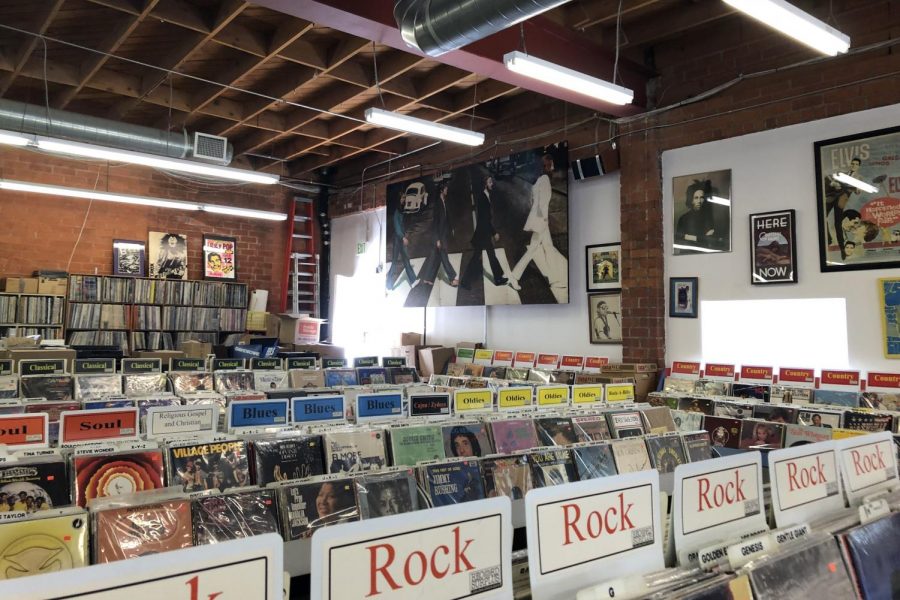Record resurgence: Vinyl records offer nostalgia, new experience
Photo credit: Amelia Stone
The Record Surplus store, located on Santa Monica Boulevard between South Centinela Avenue and South Carmelina Avenue, has been in business since 1985. The store sells vinyl records, CDs and other music-related items.
If you find yourself sorting through albums of various music genres as the faded sound of classic rock music plays in the background, you may be at a record shop.
While the phonograph, the first version of the vinyl record, was invented in 1877, the style of music listening is making a comeback, as explained by the owner of the Record Surplus store, Neil Canter.
“Back in the ’70s and ’80s and into the ’90s, there were so many record stores, and then they all started going out of business in the 2000s,” Canter said. “Now there’s so many record stores again, so obviously there’s a demand, enough demand to have that many stores.”
Canter explained why there has been a resurgence of vinyl records and record stores in 2019.
“It’s a gathering place for people who want to look for, maybe, music that… they don’t know about. We have a lot of people who come in here and… they’ll say ‘I came in looking for one thing, I didn’t find it, but I found all of these instead,'” Canter said. “You [are able to] come in and discover things that you wouldn’t [by] going online.”
Sophomore Gianna Lotman values the importance of listening to music on vinyl rather than looking for it online.
“I’m just a huge fan of vintage things in general, and I’m also a huge fan of old classic rock,” Lotman said. “I feel like if you’re truly… wanting to listen to classic rock, you should listen to it in the form that people used to listen to it. It’s a… grounding feeling, because it brings you back to this [other] time… Music is such a powerful thing and it really does show and… evoke all of these emotions from you. And I think that by listening to it on a record, it just, it’s a whole different experience.”
Canter said that the record store has allowed him to explore new music that he has not heard before.
“My tastes have changed over the years,” Canter said. “I got into classic rock… and then I discovered oldies, ’50s surf music, and rockabilly music, and blues and some country.”
The Pew Research Center suggests that the popularity of vinyl records is surging and that listeners may prefer the safety net of a physical device rather than the uncertainty of clicking a button online.
Paulette Kasal, a singer who established the Music Castle, a music academy in Santa Monica, said she believes the benefits of vinyl records are prevalent in the connection the listener makes with the music.
“[Vinyl has] kind of started to come back more, which is a great thing because… people like to collect things and have something that they can kind of touch. The tactile senses have been lost with the computer age,” Kasal said. “Digital downloads just don’t get the satisfaction, which is really important, and the connection with the artists. When you have a piece of something, that brings you closer with the artists — that’s just a piece of their work.”
Sophomore Ruby Horton echoed Lotman’s thoughts on the significant difference in listening to music on a record player versus another device.
“I’m really into sound and music… and I do think what device you play music on really changes the tone of it,” Horton said.
Canter also explained how in 2019, records add a sense of connection to the music and “conjure up” a nostalgic feeling.
“Music is really important to people,” Canter said. “I see parents and their kids coming in and… I didn’t listen to the same music my parents did, but nowadays, I think kids listen to the same music their parents did.”
Horton explained her connection to music through her record player, as she is a sound and music enthusiast.
“I feel like the sound is just better quality … rather than just playing it off of a phone,” Horton said. “I’m really into sound and music, and I think… what device you play music on really changes the tone of it… it also adds such an aesthetic as well. It just… makes it much more… authentic to the music.”
Similar to Horton, Kasal said that she experiences a different sound when she listens to music on vinyl, explaining that vinyl creates a more “organic” sound when it comes to music.
“Dust falls on the record, and you’re going to hear crackling and popping,” Kasal said. “You get a more real, organic sound, whereas when you listen to… the computer, everything is perfect, and music isn’t perfect.”
One downside to vinyl, explained Kasal, is the cost. A single vinyl record costs around 22 dollars, according to The Guardian, and many artists are turning to other methods of producing music like Dropcards, which are cards that contain codes that give listeners access to music stored on them.
“Vinyl is expensive,” Kasal said. “Digital downloads like Dropcards are not that expensive.”
Though, in recent years, vinyl records have been on the rise, Canter explained that the world of record stores has been impacted by websites like Amazon, where retailers can sell records for a very low cost. Similarly, the rise of music streaming services such as Spotify, an online music database which has gained over 200 million active users, has impacted the stores. However, Canter described that there are positive effects of the expansion of these websites.
“People [will] buy a used record on eBay, and then they get it, and it’s in horrible condition,” Canter said. “If they can come into a store, they see what they buy before they’re buying it, and they get an idea of what it is… it helps us because people can come and see what they’re buying.”
Below is a playlist of the top-streamed songs by some of Canter’s favorite artists.

Amelia Stone joined the Oracle as a staff writer in 2018. She loves tennis and plays for the Archer varsity team. She is involved in Archer's Model United...













